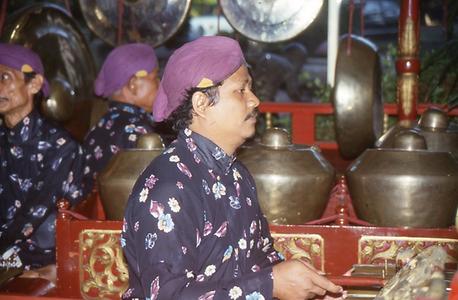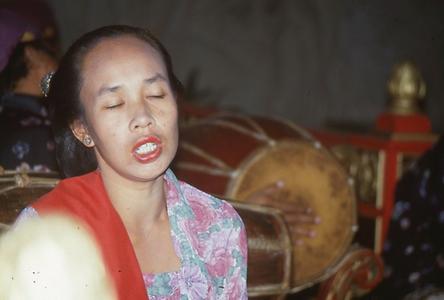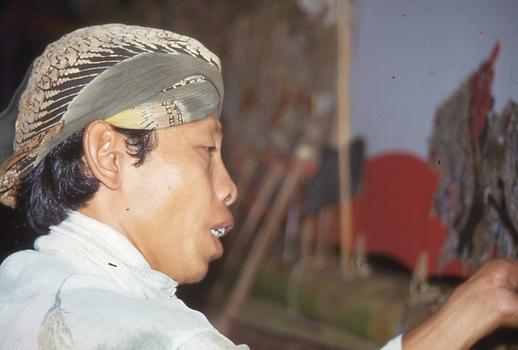Wayang kulit – Dancing shadows in tropical nights in Indonesia#
by G. Jontes
The pictures of the Wayang and the Gamelan were taken by the author in Yogyakarta in 1987. He is grateful for the permission to do so. The pictures are part of his archive "Picture flood Jontes".
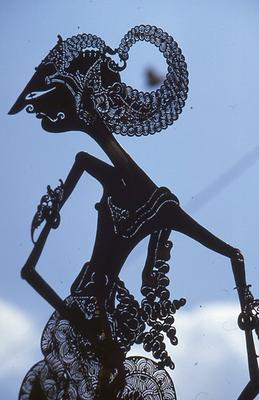
A common saying means that where is light, there is also shadow. The shadow is, so to say, the counter-world to the fullness of light of the world by daylight. Sun and moon, heavenly rulers of day and night, have been deified through the ages. The first historically identifiable monotheism was the sole worship of the sun by the “Heretic Pharao” Ekhnaton. The creative energy of the central star pushed all the other powers of nature to the brink of faith and cult.
Without the sun, the world is dark, danger-threatening and the night is the realm of demons. In the pre-scientific epochs, the phenomenon of the partial lack of light, that is the shadow, was not understood. The fact that every man casts a shadow in the sun, the length reflects the time to be measured, was one of the early discoveries and experiences of the thinkers and discoverers on mountain peaks, zikkurats and pyramids who were fascinated by the phenomena of the sky. Light and shadow represent the beginning of mathematics, geometry and astronomy in the course of the day.
The shadow with its outline reduces the human to a silhouette the interior of which is to be filled. To depict animal and human heads with a juggler’s hand and to put it together to scenes on white-washed walls was probably at the beginning of the shadow theatre. This connects several cultures from East to West on a representative level, at least technically. It was practised from the Turkish Karagöz to the Indonesian Wayang kulit and even in Southeast India and in China.
Theatre as telling stories with words, gestures and facial expressions, with costumes, props, a stage, with music and dance is a mirror of the world and human passions. The theatre creates reality beyond the moment. There is no land on earth, where the theatre in miniature version, has assumed such an impressive real form as in the Malayan world with its largest island state Indonesia.

Puppet and shadow theatres have primarily developed in this world of the thousand islands. The acting characters are made up of inanimate small figures and come to a surprising and thrilling life through the puppet master, only. In the Marionette theatre Wayang golek, the puppets are moved on sticks from below. In the Wayang kulit, there are figures, cut from buffalo leather that cast their shadows.
In addition, there is the Wayang topeng, where the actors perform with character masks in front of their face. The masks are carved from wood and painted. In the Wayang wong performances are made in the traditional way without any stylisation.
Today, Indonesia, once Netherland’s share of the exploitative colonialism of Asia, is the largest Islamic state on earth. This has not always been the case in the past. Places like the Buddhist Borobudur or the Prambanan, the Hindu heritage on the island of Java, refer to Middle Ages, where royal dynasties such as the Sailendra brought their culture from South India into this island world. Merchants brought the Islam step by step. Islam existed in a rather liberal form. Today it has been increasingly radicalized from outside. However, the expansion of Islam grew weaker over time and therefore the island of Bali (indon. Pulau Dewata „Island of Gods“) remained Hindu in religion, society and culture.
The Islam forbids depictions of living beings, that is of man, animal and plant. Instead, Islam has produced an abstract world of magnificent ornamentation and calligraphy. The ancient myths of India, however, have survived in the theatre. The heroes of the great epics of the ancient Indian Ramayana, the Mahabharatam, and other literary-mythological traditions, therefore, appear in the manifold forms of the Wayang tradition mentioned. The roots are located in India. However, there are also pre-Indian roots which refer to an ancient animism and ancestral cult, whereby the Dalang, the puppet master, has also some features of a shaman. These subjects (Indonesian Lacon) are dealt with in Wayang kulit. The name derives from the word wayang which means both spirit and shadow and the word kulit which means leather.
In 2003, this unique form of performing arts in Indonesia was declared an intangible World Heritage Site by UNESCO.
The nature of the shadow play has evolved over long periods of time and is cultivated, especially in Java and Bali. A whole crafts sector is necessary to create shadow puppets in their iconographic diversity. The basic material is buffalo leather (Indonesian "kulit"). The shape of the figures reveals already their destiny and character in the play. They have movable arms and are mounted on rods of buffalo horn with which they are moved. They are also delicately painted. This may seem strange for shadow puppets, but it is due to the fact that the audience sits separately in front of and behind the projection screen by gender. Men alone see the shadows, while women see the figures and the puppet master (Indonesian Dalang).
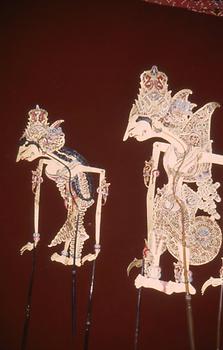
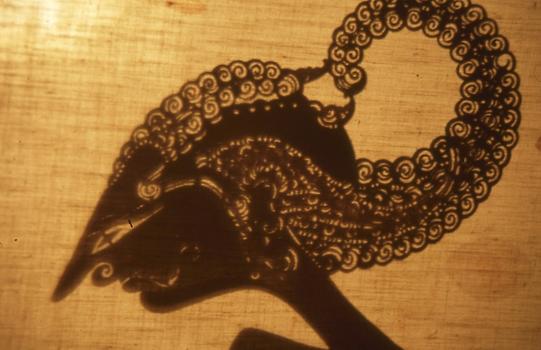
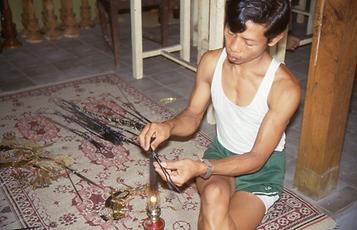


The Indonesian shadow theatre plays a big role in tourism industry. Although it is then folklorism in tourist centres, but in the same time it is still alive in the time of modern seductive media. It has even developed a form by which the government transports political content through shadow play to villages and to the thousands of islands. The shadow puppets are today popular souvenirs which, in turn, help the artisans to stick to their traditions. A concession is only that puppets are made smaller in order to fit into the suitcases of tourists.

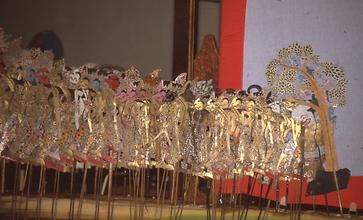

The surface on which the show appears is a taut canvas. There are always two trunks of fresh banana trees forming the basis, because the spongy interior of the interlaced leaves allows the figures to be easily fixed with their handle before they are used or removed. The puppets which the Dalang needs for a scene are already arranged and placed in the perennial. A highly-skilled Dalang has a repertoire of up to 150 puppets, and usually 50 to 60 of puppets are needed in one show.
In order to have any shadow, darkness is needed during the show. That is why the show takes place at night. It can take up to nine hours, from sunset to sunrise. The player delivers an tremendous mental and physical performance up to exhaustion. The light-emitting and, therefore, shadow-emitting lamp (Indonesian "blencong") hangs on the side where the Dalang is playing. It was formerly fed with coconut oil, but today it has usually an electric light bulb. When taking the pictures, in order to make everything visible, a flash had to be used with the consent of the player.
The Wayang kulit is always played by only one person, the Dalang. He moves the figures, explains and sings the action. Especially in the frequent battle scenes, he accentuates his words on a small hand drum or steps with the foot against the figure box (Indonesian "Koprak") when, for example, the blows of sword fall. For this purpose, he holds a wooden knocker with his toes.
Well, the show can start! At the beginning, at the end and as a scene divider stands a large, beautifully designed tree, the Gunungan or Kayonan, the wish tree.



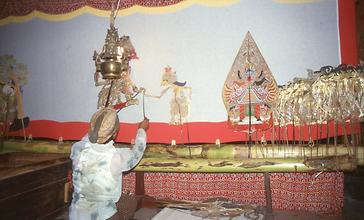


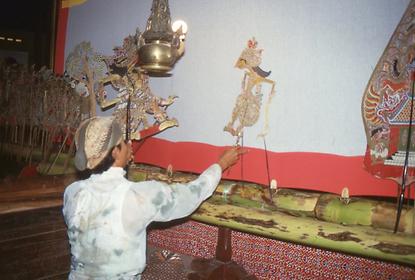


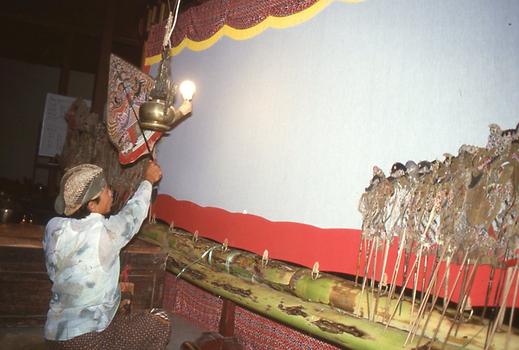

Indonesia has made a major contribution to the highly-developed musical arts that is also appreciated by people from the West. It is the ensemble music of the Gamelan which can be played from a quartet to a big real orchestra. Wayang kulit uses this kind of music. In Bali, four musicians accompany the show in its dynamism or calmness. In Java, there are numerous people who are playing instruments. The most famous gamelan ensembles of Java perform at the Javanese royal courts of Yogyakarta and Surakarta (Indonesian "Kraton").
This traditional music of Java and Bali is played with metallophones, xylophones, drums, string instruments, flutes and also singing. The main melody (Indonesian "balungan") is performed by the volume of metallophones (Indonesian "gGender") which are beaten by hammers. The music is accompanied by solo instruments, i.e. drums (Indonesian "kendang"), a flute (Indonesian "suling") and a lute (Indonesian "rebab"). A female voice (Indonesian "pesindhén") forms the vocal and commenting part. Gamelan music contains elements which, by their very nature, refer not only to the neighbours of India and China. The name of the string instrument rebab goes back to the Arabic word rabab and represents the Islamic part of this music.
Auch eine Art Rahmenrassel aus Bambusstäben namens Anglungk kommt vor. Holz tönt auch aus dem Xylophon Gambang. Ein Metallophon in einem reich verzierten Holzkasten ist das Saron. Der musikalische Impressionismus Europas hat aus der Gamelanmusik den großen Gong (indon. gong agong) übernommen. Kleinere Gongs heißen Bonang, der Kesselgong Kenong.
There is also a kind of maraca from bamboo poles and called "anglungk". A wooden sound comes from the xylophone Gambang. A metallophone in a richly decorated wooden box is called Saron. The musical impressionism of Europe has taken over the great gong (Indonesian gong agong) from gamelan music. Small gongs are called bonang, the kettle gong has the name kenong.
There is no musical notation. The musicians are working jointly. Local and regional traditions determine the tuning of each ensemble. Different scales contain 4, 5, 7, or eight tones. Music is a part of traditional life in Indonesia. Gamelan is performed on the occasion of religious ceremonies and events from birth to death.
The music accompanies dancing and theatre. In the touristic marketing strategy of today, it constitutes a sounding background of the Barong drama, the Kecak and the Legong dance and contributes to the magic of the colourful mythological performances.
The musicians of a gamelan orchestra are costumed in the same colour from head to toe. Their face expression during the game does not show routine indifference, but concentration in attentive seriousness and great dignity. A glance into such a face proves this:








